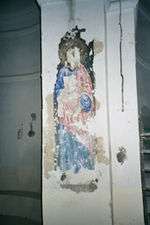Develi
| Develi | |
|---|---|
 Develi | |
| Coordinates: 38°23′19″N 35°29′33″E / 38.38861°N 35.49250°ECoordinates: 38°23′19″N 35°29′33″E / 38.38861°N 35.49250°E | |
| Country |
|
| Province | Kayseri |
| Government | |
| • Mayor | Mehmet Cabbar |
| • Kaymakam | Harun BAŞIBÜYÜK |
| Area[1] | |
| • District | 1,897.94 km2 (732.80 sq mi) |
| Population (2012)[2] | |
| • Urban | 37,875 |
| • District | 64,381 |
| • District density | 34/km2 (88/sq mi) |
| Website |
www |
Develi is a town and district in Kayseri Province in Central Anatolia Region, Turkey.
History
The town's name is reported to derive from Devle Bey, a Seljuk commander of Alp Arslan, (not to be confused with later Sâhib Ata and Dulkadir Devle Beys), and who was also named Dev Ali ("Ali the Giant"), and leader of an Oghuz Turkish clan of the same or of a similar name (Devleoğlu or Develioğlu). The commander's 1094-built tomb stands near the Byzantine castle that he had captured (called Zengibar Castle today, not to be confused with homonymous castles in Malatya and Bozkır) and which commands the plain of Develi.
Zengibar was used as a name for the town until the first centuries of the Ottoman rule, as was Everek, the name of a town quarter today, through successive displacements of the center. The fact that the neighboring district of Yeşilhisar was historically named Develi Karahisar also sometimes led to confusion among the references relating to the two centers.
The town was once composed of four adjoining parts, the Turkish town center of Develi, Greek quarter of Agiostan (spelled as "Aygösten" in modern Turkish sources which cite the quarter and/or the name as Armenian), and the two Armenian neighborhoods of Evereg and Fenesse (which were separated from each other by the centrally situated Turkish quarter).
The old houses in stone built as of the first half of the 19th century until the early 20th century still stand for the most part, although many are in need of repair and of being used in full. Close to Kayseri, by which it is separated by the Mount Erciyes, Develi prospered thanks to the trade movements through and around the regional metropolitan center, although the available agricultural land is rather scarce. Aşık Seyranî, one of the most important 19th century poets within the Turkish folk literature tradition, was a native of Develi. The family of Turkey's current president Abdullah Gül is from Develi.
Develi's 200-year-old Armenian church in Everek quarter is making local news in recent years, since the decaying building had been first transformed into a mosque in 1978 and, when routine maintenance works were initiated in 1998, it was discovered that the interior decoration was still very much present, simply covered with plaster as they were during the 1978 transformation. The discovery led to an ongoing divergence of opinions between the national authority for foundations, responsible for maintenance of mosques in Turkey, which is in favor of covering the cross and Virgin Mary figures again, and Kayseri Governorship's cultural protection unit which advocates a restoration to their state of origin, a move that would put an end to the edifice's use as a mosque, this use currently being restrained to a part of the building until an official decision is made. In 2004, in order to protect the cultural heritage, the works were ordered to be stopped by the then mayor of Develi, Ali Ağca, while an intermediate solution was found in between.[3]

See also
References
- ↑ "Area of regions (including lakes), km²". Regional Statistics Database. Turkish Statistical Institute. 2002. Retrieved 2013-03-05.
- ↑ "Population of province/district centers and towns/villages by districts - 2012". Address Based Population Registration System (ABPRS) Database. Turkish Statistical Institute. Retrieved 2013-02-27.
- ↑ Article: "Camiye camlı rötuş" Check
|url=value (help) (in Turkish). NTV Turkey.
External sources
- Develi web portal
- Krikorian, Aleksan. Evereg-Fenesse: Its Armenian History and Traditions. Detroit, MI: Evereg-Fenesse Mesrobian-Roupinian Educational Society, 1990. 186 pp.
- Evereg Fenesse Educational Society
- Der-Sarkissian, Jack. “A Tale of Twin Towns: Everek and Fenesse.” Armenian Kesaria/Kayseri and Cappadocia . Ed. Richard G. Hovannisian. Costa Mesa, California: Mazda Publishers, 2013. https://www.researchgate.net/publication/260676697_A_Tale_of_Twin_Towns_Everek_and_Fenesse

